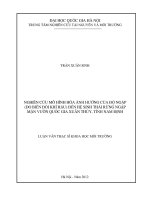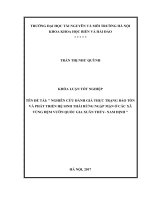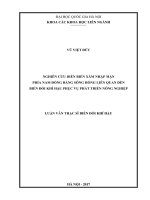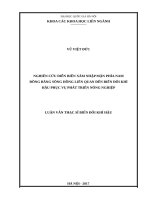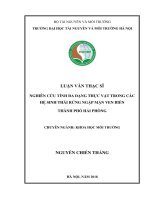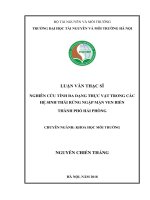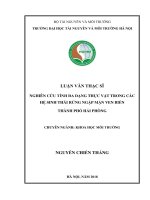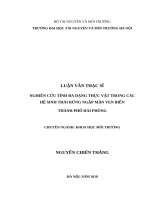Tóm tắt tiếng anh: Nghiên cứu, đánh giá tổn thất và thiệt hại hệ sinh thái rừng ngập mặn Vườn quốc gia Mũi Cà Mau liên quan đến biến đổi khí hậu.
Bạn đang xem bản rút gọn của tài liệu. Xem và tải ngay bản đầy đủ của tài liệu tại đây (1.03 MB, 31 trang )
MINISTRY OF NATURAL RESOURCES AND
ENVIRONMENT
INSTITUTE OF METEOROLOGY, HYDROLOGY
AND CLIMATE CHANGE
Nguyen Thi Ngoc Anh
RESEARCH AND EVALUATION OF LOSSES
AND DAMAGES OF MANGROVE
ECOSYSTEMS IN MUI CA MAU NATIONAL
PARK RELATED TO CLIMATE CHANGE
Field of study: Climate Change
Code: 9440221
SUMMARY OF DOCTORAL THESIS
Hà Nội, 2022
The thesis is completed at:
Institute of Meteorology, Hydrology and Climate Change
Supervisors:
1. Ph.D. Nguyen Trung Thang
2. Ph.D. Do Nam Thang
Reviewer 1:………………………………………………
Reviewer 2:………………………………………………
Reviewer 3:………………………………………………
The thesis shall be defended in front of the Thesis
Committee at Institute Level at Institute of Meteorology,
Hydrology and Climate Change
At
hour
date
month
year
The thesis can be found at:
- Library of Institute of Meteorology, Hydrology and
Climate Change
- Vietnam National Library
LIST OF ANNOUNCED WORKS OF
AUTHOR RELATED TO THE THESIS
1. Nguyen Thi Ngoc Anh, Nguyen Trung Thang (2019) “Some
issues about loss and damage caused by climate change”, Journal of
Natural Resources and Environment, Issue 1 – October 2019.
2. Nguyen Trung Thang, Nguyen Thi Ngoc Anh (2020),
“Community-based assessment of losses and damages related to
climate change – experiences of some countries and directions for
application to Vietnam”, Theme III No. 9, Environmental Journal.
3. Nguyen Thi Ngoc Anh, Tran Dang Hung, Le Phuong Ha
(2021), "Application of machine learning methods - decision trees in
assessing mangrove changes in Dat Mui commune", Journal of
Change Science. climate number 20, December 2021.
4. Nguyen Trung Thang, Nguyen Thi Ngoc Anh, Nguyen Sy
Linh, Dao Canh Tung (2022), "Assessment of loss and damage caused
by climate change: from theory to practice", Monograph, Dai
Publishing House. Hanoi National University.
5. Nguyen Trung Thang, Nguyen Thi Ngoc Anh, Dao Canh
Tung, Tran Quy Trung (2022), Overview of methods of assessing loss
and damage related to climate change, Journal of Science: Political
Research Books and Management (No. 02/2022), Hanoi National
University
1
INTRODUCTION
1. Make a problem
Mangroves and ecosystems Coastal areas play a great role in
economy, ecology and environment, have important functions for the
population community such as: providing food, foodstuffs and
medicinal herbs; coastal protection, windbreak, wave break; improve
coastal water quality; carbon storage; is the habitat of wild animals; is
an educational, research and entertainment environment. However,
according to the recent Intergovernmental Panel on Climate Change
(IPCC) forecast, due to the impacts of climate change, mangrove
forests along the coast are predicted to decrease in area and function.,
growth ability. Located between land and sea at low latitudes,
mangroves are a vulnerable area to climate change.
Around the world, the loss and damage (L&D) caused by
climate change has been mentioned, formed and developed by the
United Nations Climate Change Summit (UNFCCC). through the
Conference of the Parties (COP) from 2007 to present. The 2015 Paris
Agreement also mentioned that the parties recognized the importance
of preventing, minimizing and addressing loss and damage related to
the adverse effects of climate change, including climate change
events. extreme weather and slow-moving events and the role of
sustainable development in reducing the risk of loss and damage.
Participants must increase understanding, action, and support, on a
cooperative basis, about the losses and damages resulting from the
adverse impacts of climate change. Article 8 of the Agreement stated
8 areas of cooperation and facilitation to enhance mutual
understanding, action and support, of which non-economic losses are
one of the mentioned contents.
2
In Vietnam, the loss and damage to mangrove ecosystems due
to climate change has not been studied much to measure and evaluate.
Stemming from this practice, the thesis “Research on, assessment of
loss and damage to mangrove ecosystems in Ca Mau Cape National
Park related to climate change “was built with the expectation of the
results of the study. the study will provide a scientific basis for managers
and experts to identify and determine the damage caused by climate
change to the mangrove ecosystem; develop orientations for
management and conservation of mangroves in the context of
reasonable climate change.
2. Research objective
(i) Identify appropriate methods and procedures to assess loss
and damage to mangrove ecosystems in Ca Mau Cape National Park
related to climate change
(ii) Assess the loss and damage to the mangrove ecosystem in
Ca Mau Cape National Park related to climate change and propose
solutions to minimize.
3. Objects and scope of research
3.1. Research subjects
The object of the study is the loss and damage caused by
climate change to the mangrove ecosystem in Mui Ca Mau National
Park, namely (i) loss and damage to services provided ( supplies of
wood, firewood, medicinal herbs, aquatic products/seafood); (ii) loss
and damage to support services (losing the area of mangrove forest
which is a breeding ground for mangrove species and species); (iii)
loss and damage to regulatory services (reducing protection against
coastal erosion) and; loss and damage to cultural and entertainment
services (focusing on tourism services).
3
3.2. Research scope
- Spatial scope: loss and damage assessment for the mangrove
ecosystem in Ca Mau Cape National Park, which is concentrated in
the area of Dat Mui commune.
- Time range: assessment of loss and damage to mangrove
ecosystems in Ca Mau Cape National Park in the period from 19892020 (20-30 years ago) and forecast to the year 2050-2100.
4. Research question
- What methods and processes can be used to combine public
and scientific knowledge to assess loss and damage to mangrove
ecosystems ?
- How is the loss and damage to the mangrove ecosystem in
Ca Mau Cape National Park related to climate change over the past
20-30 years? Where are the focus losses and damages ?
- What solutions can reduce the loss and damage to the
mangrove ecosystem? Ca Mau Cape National Park ?
5. Dissertation defending points
Point 1. Community knowledge is valuable information in the
assessment of loss and damage to mangrove ecosystems. However,
community knowledge is not enough, it needs to be combined with
scientific knowledge to be able to assess the loss and damage to
mangrove ecosystems related to climate change.
Point 2. The mangrove ecosystem of Mui Ca Mau National
Park suffers from many losses and damages related to climate change,
in which the services of providing aquatic products and services, and
the prevention and control of landslides. Coastal erosion is the main
loss and damage.
Point 3. Structural and non-structural solutions can be applied
4
to minimize loss and damage to mangrove ecosystems related to
climate change.
6. Scientific and practical significance
6.1. Scientific significance
Provide a theoretical basis for the loss and damage caused by
climate change; International experience on loss and damage
assessment in general and loss and damage to mangrove ecosystems
in particular, is a useful reference for scientific research and policy
planning. book on climate change response, management and
restoration of mangroves.
6.2. Practical significance
Research results are the basis to help managers and policy
makers identify the type and extent of loss and damage in general
related to climate change and the mangrove ecosystem in particular;
on that basis, propose solutions to proactively respond to abnormal
manifestations of climate change and natural disasters in the coming
time, and at the same time, sustainably manage the mangrove
ecosystem in the context of climate change. post.
7. New contributions of the Thesis
- Currently, comprehensive research on loss and damage is
still limited, there are no guidelines for assessing loss and damage due
to climate change as well as processes, methods and tools to apply.,
especially with non-economic losses and damages. In Vietnam, the
issue of non-economic loss and damage, particularly with mangrove
ecosystems related to climate change, has not been studied. Therefore,
within the scope of implementation, the thesis has clarified the
scientific basis for loss and damage mangrove ecosystems related to
climate change on the basis of an overview study of loss and damage
5
assessment in general and for mangrove ecosystems in particular
related to climate change.
- The thesis has proposed methods and procedures for
assessing loss and damage to ecosystems mangroves in relation to
climate chang. On that basis, by combining qualitative and
quantitative assessment methods, the thesis has assessed the loss and
damage to the mangrove ecosystem in Mui Ca Mau National Park
related to climate change and propose solutions to minimize loss and
damage to ecosystems mangrove forests in the context of increasingly
complex climate change.
8. Thesis structure
In
addition
to
the
Introduction,
Conclusion
and
Recommendat-ions, the thesis consists of Chapters with the following
main contents:
Chapter 1. Overview of assessment of loss and damage to
man-grove ecosystems related to climate change
Chapter 2. Approach and methodology to study loss and
dama-ge to mangrove ecosystems in Mui Ca Mau National Park
related to climate change
Chapter 3. Results of assessment of loss and damage to mangrove ecosystems in Ca Mau Cape National Park related to climate
change.
CHAPTER 1. OVERVIEW OF ASSESSMENT OF LOSS AND
DAMAGE TO THE MASSROVAL FOREST ECOSYSTEM
RELATED TO CLIMATE CHANGE
1.1. Theoretical basis for assessment of climate changerelated loss and damage to mangrove ecosystems
6
There are many authors and organizations that offer the
concept of loss and damage caused by climate change. “The loss and
damage caused by climate change is understood as the inevitable loss
after implementation of mitigation and adaptation measures. Loss and
damage can be the result of sudden-onset events, such as storms,
floods, droughts, heat waves, etc., or slow-moving processes over
time. slow-onset events such as temperature rise, sea level rise,
saltwater intrusion, ocean acidification, desertification... According to
UNFCCC, climate change related losses and damages can be
classified into two categories: (i) economic loss and damage and; (ii)
non-economic loss and damage.
Loss and damage to the mangrove ecosystem related to
climate change can be understood as the inevitable loss and damage to
the services that the mangrove ecosystem provides after the implement
solutions to mitigate and adapt to climate change. In which, the most
obvious manifestation that climate change causes to the ecosystem
Mangroves are sea level rise that causes loss of mangrove areas,
causes coastal erosion, and reduces the services that mangrove
ecosystems provide.
According to IPCC 2012, there are currently 02 approaches to
loss and damage assessment, including: (i) assessment from the
perspective of disaster risk reduction (DRR) and; (ii) climate change
adaptation (CCA) assessment. For each approach, it is divided into
pre- or post-disaster assessment, qualitative or quantitative
assessment.
1.2. Overview of Vietnam's policies and laws on
assessment of climate change related losses and damages to
mangrove ecosystems
7
In Vietnam, recently, a number of documents related to the
assessment of losses and damages related to climate change have also
been issued, such as the Law on Environmental Protection 2020, the
National Strategy on Climate Change in the second half of the year.
period to 2050, National plan to adapt to climate change for the period
of 2021-2030, with a vision to 2050, Circular No. 01/2022/TTBTNMT dated January 7, 2022 of the Ministry of Natural Resources
and Environment…
Protect and restore ecosystems Mangrove forest in the current
period is the right orientation that the Party and State continue to pay
attention and promote through documents such as Resolution No.
06/NQ-CP dated January 21, 2021 of the Government issued by the
Government. 24-NQ/TW, Vietnam's forestry development strategy
for the period of 2021 - 2030, with a vision to 2050, the project
"Protecting and developing forests in coastal areas”to respond to
climate change and promote green growth in the 2021-2030 period”.
1.3. Overview of domestic and international research on
assessment of loss and damage to mangrove ecosystems related to
climate change
- Research abroad: in each study, the authors use different
methods to assess loss and damage. The method that can be used for
qualitative assessment is the participatory method of the local
community. To quantify ecosystem loss/damage basically use
valuation techniques (environmental valuation methods) or remote
sensing image analysis to assess damage to mangroves such as the
extent of erosion coast (affecting services provided by mangroves).
- Domestic research: In Vietnam, there have also been a
number of studies and assessments of losses and damages related to
8
climate change, but there has not been any specific research on
assessment of losses and damage to ecosystems. mangrove forest.
Vietnam still lacks research on scientific basis, selection of
appropriate methods to assess loss and damage caused by climate
change to non-economic types in general and mangrove ecosystem in
particular..
1.4. Overview of the study area
National Park is the land located at the end of the Ca Mau
peninsula. This is the only area in Vietnam with 3 sides bordering the
sea, affected by two water regimes. Ca Mau Cape National Park is an
area that is adversely affected by natural disasters and climate change
due to its geographical characteristics, located in the area affected by
the monsoon climate, which is directly adjacent to the impacts of
natural disasters and climate change. tidal dynamics in the East and
West Seas. This is a natural mangrove ecosystem with high value in
terms of biodiversity, natural landscape, environment and is very
important in coastal protection, windbreak, anti-erosion breakwater,
land immobilization in coastal areas. the process of land formation
into the East Sea. However, the livelihood of local people is highly
dependent on the resources provided by the mangrove ecosystem of the
National Park.
1.5. Identify gaps and issues to be researched
- There have not been many studies on methods of assessing
loss and damage to mangrove ecosystems in the world and in Vietnam.
- There are no studies on assessment of loss and damage to
mangrove ecosystems in Vietnam in general as well as for Ca Mau
area and Ca Mau Cape National Park in particular.
9
- There are no studies to propose solutions to minimize loss
and damage to the mangrove ecosystem in Ca Mau Cape National
Park.
CHAPTER 2. ACCESSORY AND METHODOLOGY OF
RESEARCH DAMAGE AND LOSSES
2.1. Approach
- Interdisciplinary approach: Climate change affects many
sectors and fields and occurs continuously with the movement of the
earth. Therefore, the assessment of losses and damages should be done
in a comprehensive, interdisciplinary approach.
- Top-down and bottom-up approaches: A top-down approach
to clarify the current situation, organizational structure, and model of
mangrove ecosystem management in Mui Ca Mau National Park in
the context of climate change.. In order to grasp the actual situation of
loss and damage, the PhD student conducted an investigation and
survey to collect information and data of the parties related to the loss
and damage. mangrove ecosystems due to climate change.
- Historical approach: To assess the loss and damage to the
mangrove ecosystem of Mui Ca Mau National Park, it is necessary to
understand the historical characteristics of the study area, the specific
manifestations of natural disasters. historical distinction and its impact
on mangrove ecosystems.
- Integrated approach, combining qualitative and quantitative
assessment: The community-based assessment method is applied
through surveys, surveys, and interviews with people to identify and
determine its quality. extent of loss and damage to mangrove
ecosystems in Ca Mau Cape National Park. On that basis, the thesis
applies remote sensing, GIS and economic valuation methods to
10
determine fluctuations in coastal erosion prevention and control
services.
- Market Access: From the market approach, it is possible to
propose a market-based solution in mangrove protection and climate
change response to encourage and motivate all economic sectors to
participate in this activity.
2.2. Research Methods
- Method of document review: carried out through the
inheritance of existing studies on international, regional and
Vietnamese losses and damages. The thesis has collected and
researched domestic and international documents on the theoretical
basis and international experience related to loss and damage.
-
Methods
of
information
collection,
sociological
investigation: implemented in community-based loss and damage
assessment for mangrove ecosystems in Ca Mau Cape National Park.
- Remote sensing method and geographic information system:
used to assess shoreline changes, on that basis to determine loss and
damage of coastal erosion prevention services of Mui Ca Mau
National Park under the impact of climate change and sea level rise.
- Valuation method: The replacement cost method is used to
estimate the damage value of coastal protection and anti-erosion
services of Ca Mau Cape National Park; the market price method is
used to estimate the damage value and the value transfer method is
used to determine the loss value of the services provided by the
ecosystem.
- Methods of statistics, synthesis, comparison and analysis: are
used in the process of developing the content of the thesis, helping to
11
establish the data and scientific basis for the statements and conclusions
used in the thesis. judgment.
- Expert method: used to determine and select methods of loss
and damage assessment The mangrove ecosystem related to climate
change of Ca Mau Cape National Park is suitable.
2.3. Analysis and selection of methods and procedures for
assessing loss and damage to mangrove ecosystems in Mui Ca Mau
National Park related to climate change
The thesis selects the main method to assess the loss and
damage to the mangrove ecosystem of Mui Ca Mau National Park
related to climate change :
- Qualitative assessment through community-based survey
and assessment;
- Quantitative assessment by remote sensing/GIS method and
economic evaluation.
The evaluation process includes the following steps: (1)
Determining the objectives, scope, and plan of the assessment; (2) An
overview study of climate change, impacts and identification of losses
and damages; (3) Selection of assessment methods and tools; (4)
Organizing field surveys; (5) Synthesize and analyze the evaluation
results.
CHAPTER 3. RESULTS OF ASSESSMENT OF DAMAGE
AND DAMAGE TO THE ECOLOGY OF THE MULTIGROUNDED FOREST ENVIRONMENTAL GARDEN EVERY
CA MAU RELATED TO CLIMATE CHANGE
3.1. Community-based assessment results
3.1.1. About the manifestation of climate change
Most people noticed changes in temperature, rainfall, sea level
12
rise and weather phenomena such as storms and floods during their
stay in the National Park. In which, 48% of the interviewees said that
the temperature has increased significantly to a sharp increase; 51%
said that the amount of rain showed a change from many to strong;
especially 77% said that there is a sign of sea level rise of many to
strong levels and; 70% said that there are many to strong and clear
manifestations of extreme weather phenomena.
100%
80%
60%
40%
20%
0%
Temperatures Rainfall change Sea level rise
Extreme
rise
weather events
have increased
Hardly
Little
Rather
Very
Strongly
Other
Figure 3. 1. Manifestations of climate change according
to people's assessment
3.1.2. About loss and damage to mangrove ecosystem
services
- Loss and damage to services provided:
For the supply of wood, firewood and medicinal herbs of
mangroves: The survey results showed that 96% of the respondents
said that there is a decrease in the supply of wood, firewood and
medicinal herbs of the mangrove forest. in which 83% assessed the
decline at a low level. The reasons for the assessment were selected
due to many factors, from the impact of climate change (38%), land
use conversion (50%), over-exploitation and pollution from
production activities, activities (45%). For aquatic and marine
13
products of mangrove forests, 100% of the respondents answered that
there was a decrease in the production of aquatic and marine products
of mangroves, of which 24% assessed the decline at a strong level;
55% rated the decline as moderate. The impact of climate change is
the main cause of the decline in fishery production (82%), in addition
to being assessed due to other causes such as overfishing (36%), water
(34%).
90
120
80
70
100
60
80
50
40
60
30
40
20
10
20
0
Supply of timber
products, herbs,
medicinal plants
Seafood
production
Other
6
0
Deforestation
50
0
0
over-exploitation
45
36
3
24
Environmental
pollution
2
34
3
55
building infrastructure
0
0
Slightly reduced
83
18
Climate Change
38
82
Insignificantly reduced
8
3
0
Supply of timber
products, herbs,
medicinal plants
Seafood production
Increased
0
0
Greatly reduced
3
Much reduced
Significantly reduced
Figure 3.3. Survey results on the
Figure 3.4. Survey results on
level of service supply decline of
causes of service supply decline
Mui Ca Mau National Park
in Mui Ca Mau National Park
- Loss and damage of support services
Regarding the area of mangroves and mangrove species, 99%
of the respondents answered that there was a decrease in the area of
mangroves, however, 41% said that the reduction was not significant;
52% have a slight decrease. The majority attributed the decline to the
impact of climate change (about 96%), the rest attributed the
destruction of mangroves to aquaculture (21%) and the over-
14
exploitation of firewood. level (11%).
Regarding mangrove species, 97% of the respondents
answered that there was a decrease in the number of mangrove species,
however 56% said that the reduction was not significant; 42% have a
slight decrease. The reason for the decline is the impact of climate
change (about 52%). Some species that people consider to be in
decline are: fish sauce, parrots, tigers, red cotton parakeets, price,
pages, red toads...
100%
90%
80%
70%
60%
50%
40%
30%
20%
10%
0%
120
100
80
60
40
20
Area of
mangrove
forest
Plants in the
mangrove
forest
Increased
0
0
Area of mangrove
forest
Plants in the
mangrove forest
Greatly reduced
0
0
Other
5
2
Much reduced
2
0
Deforestation
21
6
Significantly reduced
5
2
over-exploitation
11
40
Slightly reduced
52
42
Environmental pollution
0
3
Insignificantly reduced
41
56
Climate Change
96
52
0
Figure 3.5. Survey results on
Figure 3.6. Survey results on
the level of decline in support
causes of decline in support
services of Ca Mau Cape
services of Ca Mau Cape
National Park
National Park
- Regulatory service loss and damage
For coastal protection and anti-erosion services, 96% of
respondents said there was a decline in coastal protection and antierosion services, of which 64% rated the decline at a strong level; 29%
rated the decline as moderate; 7% rated the decline as low level. The
majority of people identified the impact of climate change as the main
reason for the reduction in protection services (84%).
15
84
90
80
70
60
40
Slightly reduced
29%
46
50
Insignificantly reduced
7%
30
Significantly reduced
20
64%
Much reduced
10
Greatly reduced
Other
Landslides and
subsidence
1
0
0
0
0
Underg
Illegal round
Defores
Climate
sand
water
tation
Change
mining extracti
on
46
1
0
84
Figure 3. 7. Survey results on the Figure 3.8. Survey results on
decline
in
prevention
coastal
and
erosion the causes of decline in
protection coastal erosion prevention
services of Mui Ca Mau National and protection services of Ca
Park
Mau Cape National Park
- Loss and damage to cultural services
Regarding tourism services, the majority of people believe
that the number of tourists to the National Park increases every year,
only 30% think that there is a decrease in the number of tourists
visiting the National Park. In which, 80% rated the decline at a
negligible level.
3.1.3. About adaptation solutions to climate change
For solutions to adapt to climate change, reduce the impact of
climate change on the mangrove ecosystem of Ca Mau Cape National
Park, 100% of the people answered yes. in households, mainly
embankment to prevent saline intrusion, job change, cropping
season... However, the effectiveness of the solutions is not high. 85%
of respondents said that after solutions have been implemented at
households or from local authorities over the years, losses in fish and
seafood production or the extent of coastal erosion still remain. take
16
place. The assessed solutions can only partially reduce the impact of
climate change. 6% think that these solutions are not really effective
(do not reduce the impact of climate change).
3.2. Assessment results by remote sensing/GIS method
combined with economic evaluation
3.2.1. Assessment of changes in mangroves through shoreline
changes in Ca Mau Cape National Park under the impact of sea level
rise
The results of shoreline variability in Ca Mau Cape show that,
from 1989 to 2020, in the western coast area, the accretion process
prevails, in the east coast area, the coastline changes sharply.
complicated developments, in which erosion predominates. On the
East coast, the average erosion rate was about 7.62 m/year during the
period 1989-2020 (Figure 3.18). In contrast, on the west coast in the
period from 1989-2020, the accretion trend took place strongly, the
average accretion rate was about 77.4 m/year. However, in general,
compared with the baseline in 1989, by 2020, the erosion process on
the East coast will still prevail with an average landslide length of
12.89 m/year, while the West coast will still be dominant. is always
accreted with an average accretion length of about 11.5 m/year
(Figures 3.18, 3.19).
17
Figure 3.18. Changes in the
Figure 3.19. Changes in the
East Coast of Cape Ca Mau in
West Coast of Cape Ca Mau
the period 1989-2020
in the period 1989-2020
Based on the results of the shoreline calculated from the
DSAS software to evaluate in more detail the area of erosion changes
for the whole period 1989 - 2020. Carry out overlapping of the
shoreline 1989 - 2020 with more details on the area of change. erosion
for the whole period 1989-2020. Conduct overlapping of two
shorelines 1989 and 2020.
The annual loss of land due to erosion ranges from a few tens
of meters to hundreds of meters depending on each year and location,
however, in the period from 1989 to 2020, the results show that the
average area of land lost is 248,133 ha/ five.
18
Figure 3.20. Overlapping shorelines for the period 19892020
3.2.2. Estimating loss and damage to mangrove ecosystems
through economic valuation
a. Quantification of damage, protection value, against
coastal erosion
The thesis uses information on construction costs of artificial
structures, specifically dykes in Ca Mau province. Currently, there is
a project to build a coastal protection embankment in Vam Vuy
estuary area with a length of 3,343 m, a cost of VND 118,154 billion
[92]. Thus, each 1 km (1,000m) of coastline needs about 35.34 billion
VND to build the embankment. As above analysis, in the study area,
the east bank erosion averaged 12.89 m/year in the period 1989-2020.
The project of building a coastal protection embankment in the area of
Vam Vuy estuary belongs to class IV sea dykes, with a lifespan of 50
years. Consider the same level of support in coastal erosion prevention
of the embankment system for each time unit (year). Thus, the annual
19
cost of landslide prevention for 50 years by building protective
embankments is: 335,064 million VND/year, ie the value of loss and
damage due to coastal erosion at the coast in this area is about 335,064
million VND/year.
b. Quantification of damage to services providing aquatic
resources
Results of interviewing 114 households in the study area, the
average income per household from aquatic resources is about 66
million VND/household/year. According to statistics of the People's
Committee of Dat Mui commune, the total number of aquaculture and
fishing households is 1338. Thus, the estimated total income from
aquatic resources is: 88,308,000,000 VND/year. According to local
people, under the impact of climate change and extreme weather
events, about 8% of respondents assessed that their income from
aquatic resources and seafood decreased from 30 -40%; 52% of people
rate the level of income reduction from 40-60%; The remaining 40%
assess the level of income reduction from 60-70% (compared to the
current cash flow value).
Therefore, if the average income from aquaculture and fishing
activities decreases by about 55% compared to 20-30 years ago, the
estimated value of fishery resources lost each year is about
1,619,000,000 – 2,428,000,000 VND/year
c. Quantification of damage to the value of mangrove
ecosystem services
thesis uses the value transfer method to estimate the damage
value of services provided by the mangrove forests of Mui Ca Mau
National Park. According to the report "Value of ecosystem services
in Ngoc Hien district, Ca Mau province”under the Ecosystem Services
20
project of the Institute of Strategy, Policy on Natural Resources and
Environment in collaboration with UNEP and GEF [34] implemented
(2013), the total value of mangrove ecosystem services in Ngoc Hien
district is 33,080,091 VND/ha/year, including supply services (wood,
firewood, fishery catch, aquaculture). ), coastal protection services,
carbon sequestration services, tourism landscape services. As
analyzed above, in the period 1989-2020, the land area in the study
area was lost about 248,133 ha.
Therefore, the estimated loss and damage of the mangrove
ecosystem in the study area in Ca Mau Cape National Park for the period
1989-2020 (calculated at 2013 prices) is about 8,188 million VND/year.
3.3. General assessment of loss and damage to mangrove
ecosystems in Ca Mau Cape National Park related to climate change
Loss and damage to mangrove ecosystems are assessed using
a community-based qualitative assessment of the service provided;
Support Services; regulatory services; entertainment and cultural
services. The services are assessed to decline at different levels, in which,
the service of providing aquatic products and seafood and the protection
and prevention of coastal erosion are the two services that suffer the most
losses and damages in the National Park. Cape Ca Mau in relation to
climate change. Loss and damage to the mangrove ecosystem in Ca
Mau Cape National Park is considered to be declining for many reasons,
from human activities such as exploitation, fishing, deforestation.
Mangrove and climate change are among the causes of loss and damage.
Estimated loss and damage to mangrove ecosystem services in
the study area of Mui Ca Mau National Park is about VND 8.188
million/year (price as of 2013). In fact, this value may be much higher
21
because the values of culture, education... as well as the current price are
not taken into account.
3.4. Uncertainties of the assessment process
- The methods used to assess loss and damage to mangrove
ecosystems related to climate change have not been studied much.
- The separation of causes of loss and damage to mangrove
ecosystems due to human activities or potential impacts of climate
change is very complicated and difficult to define clearly. clear.
- Due to limited resources, the number of samples used for
investigation and survey in Ca Mau Cape National Park is not large
enough.
- The thesis has not comprehensively and fully assessed all the
losses and damages of the ecosystem mangroves
3.5. Proposing solutions to minimize loss and damage to
mangrove ecosystems related to climate change
3.5.1. General assessment of response to climate change and
loss and damage in Ca Mau Cape National Park
National Park has implemented activities in the management
and protection of mangrove ecosystems: organize for households to
participate in forest co-management, inspection and supervision of
afforestation, forest protection and development; applying advanced
techniques to aquaculture practice; focus on developing types of
community eco-tourism...
However, there are still some difficulties: staff with high
scientific and technical qualifications is still lacking, especially in the
field of biodiversity conservation and climate change; The situation of
free migrants and illegal residents in and around the National Park has
not been arranged, arranged or relocated. There is no plan to change
22
stable occupations to create a long and sustainable life. sustainable for
the people...
3.5.2. Forecasting trends on changes in mangrove ecosystems
in Ca Mau Cape National Park related to climate change
According to the scenario of climate change and sea level rise in
2020 of the Ministry of Natural Resources and Environment, the rainfall
in Ca Mau area tends to increase in recent years and by 2100 may reach an
increase of 4-8% compared to the previous year. with the period 19901999.
The study area belongs to area 6 - Coastal area from Cape Ke Ga
to Cape Ca Mau and 7 - Coastal area from Cape Ca Mau to Ha Tien
among 7 areas where sea level rise scenarios are developed in Vietnam
Male. Assuming the mangrove area does not change and applying the
RCP 8.5 scenario, the research results predict the specific changes in the
mangrove area as follows: if the sea level rises by 28 cm by 2050, the
area will increase by 28 cm by 2050. The area of mangroves has been
reduced by about 2000 ha (24.5%), leaving only about 76% of the
current mangrove area. If the sea level rises by 75cm by 2100, the
mangrove area will decrease by about 5,226 hectares (equivalent to
71.8%), only about 20% of the current mangrove area.
3.5.2. Proposing solutions to minimize loss and damage to
mangrove ecosystems related to climate change
a) For the national level
- Implement the National Program on GHG emission
reduction through limiting forest loss and degradation; conservation,
enhancement of carbon stocks and sustainable management of forest
resources (REDD+ Program) to 2030 approved in Decision No.
419/QD-TTg dated April 5, 2017 of the Prime Minister.

